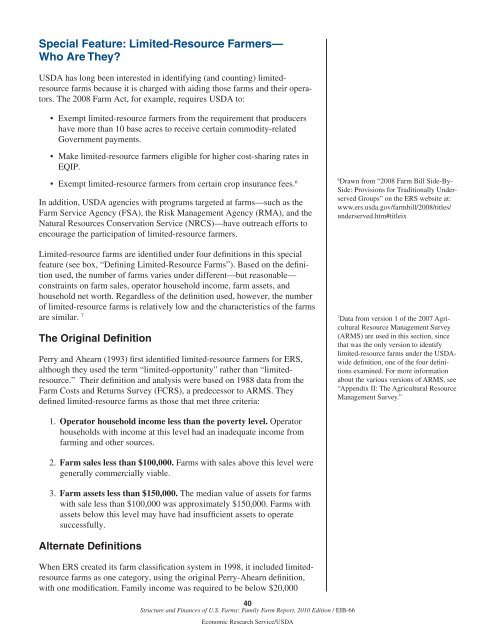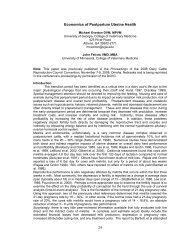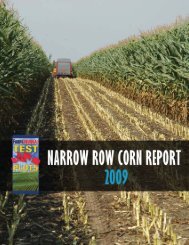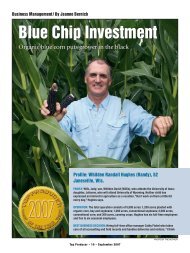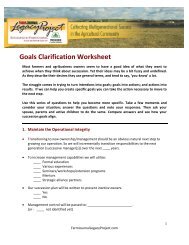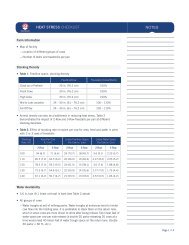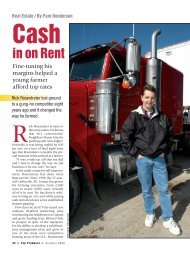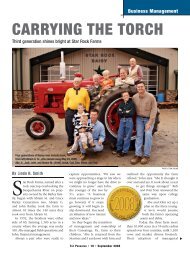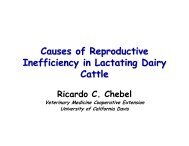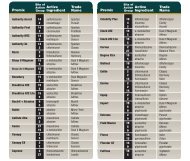Structure and Finances of U.S. Farms: Family Farm Report ... - AgWeb
Structure and Finances of U.S. Farms: Family Farm Report ... - AgWeb
Structure and Finances of U.S. Farms: Family Farm Report ... - AgWeb
Create successful ePaper yourself
Turn your PDF publications into a flip-book with our unique Google optimized e-Paper software.
Special Feature: Limited-Resource <strong>Farm</strong>ers—Who Are They?USDA has long been interested in identifying (<strong>and</strong> counting) limitedresourcefarms because it is charged with aiding those farms <strong>and</strong> their operators.The 2008 <strong>Farm</strong> Act, for example, requires USDA to:• Exempt limited-resource farmers from the requirement that producershave more than 10 base acres to receive certain commodity-relatedGovernment payments.• Make limited-resource farmers eligible for higher cost-sharing rates inEQIP.• Exempt limited-resource farmers from certain crop insurance fees. 6In addition, USDA agencies with programs targeted at farms—such as the<strong>Farm</strong> Service Agency (FSA), the Risk Management Agency (RMA), <strong>and</strong> theNatural Resources Conservation Service (NRCS)—have outreach efforts toencourage the participation <strong>of</strong> limited-resource farmers.Limited-resource farms are identified under four definitions in this specialfeature (see box, “Defining Limited-Resource <strong><strong>Farm</strong>s</strong>”). Based on the definitionused, the number <strong>of</strong> farms varies under different—but reasonable—constraints on farm sales, operator household income, farm assets, <strong>and</strong>household net worth. Regardless <strong>of</strong> the definition used, however, the number<strong>of</strong> limited-resource farms is relatively low <strong>and</strong> the characteristics <strong>of</strong> the farmsare similar. 7The Original DefinitionPerry <strong>and</strong> Ahearn (1993) first identified limited-resource farmers for ERS,although they used the term “limited-opportunity” rather than “limitedresource.”Their definition <strong>and</strong> analysis were based on 1988 data from the<strong>Farm</strong> Costs <strong>and</strong> Returns Survey (FCRS), a predecessor to ARMS. Theydefined limited-resource farms as those that met three criteria:6Drawn from “2008 <strong>Farm</strong> Bill Side-By-Side: Provisions for Traditionally UnderservedGroups” on the ERS website at:www.ers.usda.gov/farmbill/2008/titles/underserved.htm#titleix7Data from version 1 <strong>of</strong> the 2007 AgriculturalResource Management Survey(ARMS) are used in this section, sincethat was the only version to identifylimited-resource farms under the USDAwidedefinition, one <strong>of</strong> the four definitionsexamined. For more informationabout the various versions <strong>of</strong> ARMS, see“Appendix II: The Agricultural ResourceManagement Survey.”1. Operator household income less than the poverty level. Operatorhouseholds with income at this level had an inadequate income fromfarming <strong>and</strong> other sources.2. <strong>Farm</strong> sales less than $100,000. <strong><strong>Farm</strong>s</strong> with sales above this level weregenerally commercially viable.3. <strong>Farm</strong> assets less than $150,000. The median value <strong>of</strong> assets for farmswith sale less than $100,000 was approximately $150,000. <strong><strong>Farm</strong>s</strong> withassets below this level may have had insufficient assets to operatesuccessfully.Alternate DefinitionsWhen ERS created its farm classification system in 1998, it included limitedresourcefarms as one category, using the original Perry-Ahearn definition,with one modification. <strong>Family</strong> income was required to be below $20,00040<strong>Structure</strong> <strong>and</strong> <strong>Finances</strong> <strong>of</strong> U.S. <strong><strong>Farm</strong>s</strong>: <strong>Family</strong> <strong>Farm</strong> <strong>Report</strong>, 2010 Edition / EIB-66Economic Research Service/USDA


